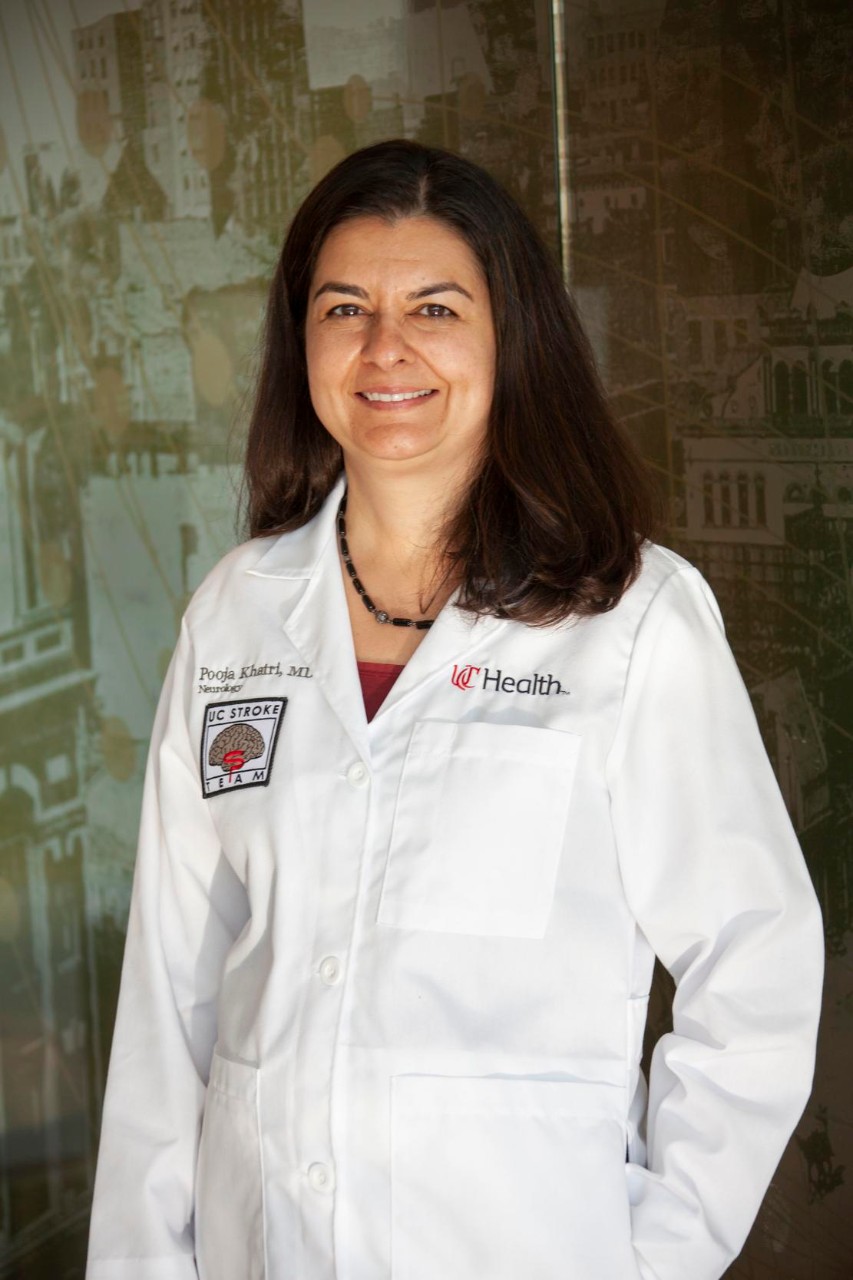
Doing clinical trials the 2024 way
UC stroke experts part of national team leading STEP platform trial
Clinical trials are an essential part of improving stroke care for patients, but each trial can also require years of planning and tens of millions of dollars from start to finish.
Two University of Cincinnati Gardner Neuroscience Institute physician researchers are part of a national team pioneering a new approach within the stroke field to make trials faster, more efficient and more adaptable as new research questions arise.
UC’s Pooja Khatri, MD, and Eva Mistry, MBBS, are two of the national principal investigators for the StrokeNet Thrombectomy Endovascular Platform (STEP) trial, the first-ever platform trial in the stroke field.
What is a platform trial?

Pooja Khatri, MD. Photo/UC Marketing + Brand.
Traditional clinical trials focus on one research question and require a planning phase that usually lasts at least two years. During the planning phase, investigators and their teams design the trial, apply for and receive grant funding, identify and train trial sites on study protocols, and build other needed infrastructure.
Khatri and Mistry explained that a platform trial can be thought of as a “trial of trials” with broad inclusion and exclusion criteria for patients. All of the initial trial planning is set up a single time, and then research questions are added or removed over time as needed.
”We keep the same base trial team/design/infrastructure while incorporating new questions with respective academic or industry leaders and amending the base design, protocol and contracts,” said Khatri, professor, vice chair of research and division chief in the Department of Neurology and Rehabilitation Medicine at UC's College of Medicine and associate director of the UC Gardner Neuroscience Institute. “On top of that, the National Institutes of Health review can use an accelerated process to review new applications to amend that one platform trial rather than evaluating a distinct new trial in standard timelines.”
The fact that there is a finite number of acute stroke patients at any given time presents an ongoing barrier for advancing research, but the platform trial structure means patients can be enrolled in several arms of the study at once, both as active participants and as control subjects.
The STEP trial is groundbreaking in the way we do stroke research. This is a 2024 way to do clinical trials.
Eva Mistry, MBBS
"In a platform trial, you can randomize patients to answer multiple questions simultaneously,” said Mistry, associate professor in the Department of Neurology and Rehabilitation Medicine in UC’s College of Medicine. “You can share patients who are in the control group so that you’re offering active therapies to more patients.”
While STEP is the first stroke platform trial, Khatri noted that the concept has been successful in oncology and infectious disease research, including government-led COVID-19 vaccine trials.
“This is one of the silver linings of the COVID pandemic, in which several countries mandated platform trials that socialized the concept more widely and led to remarkably fast treatments,” Khatri said. “The U.S. government’s Operation Warp Speed set up the ACTIV platform trials, in particular, which really paved the way for us.”
Trial details

Eva Mistry, MBBS. Photo/Andrew Higley/UC Marketing + Brand.
Care for acute ischemic stroke has seen several breakthrough advancements in the past decade, including new and improved clot-busting drugs and the growing practice of endovascular thrombectomy, a minimally invasive stroke procedure that uses a catheter to remove a blood clot from a blood vessel in the brain and restore blood flow. But at the same time, these improvements have led to many more research questions on how to optimize and improve care for each individual patient.
Khatri was one of three founding principal investigators who began work on what would become the STEP trial in 2018, identifying a need to answer these acute stroke research questions more quickly and efficiently.
“You could just go about doing that grind, answering these research questions in a regular way, doing an individual clinical trial for each question. But with platform trials, we completely, radically change the way we answer these questions,” Mistry said.
More than five years later, Khatri’s role involves overseeing the platform’s execution with her fellow principal investigators and integrating the work into the broader StrokeNet infrastructure as director of the StrokeNet National Coordinating Center housed at UC. Mistry serves as the protocol principal investigator, leading the overall operation and execution of the platform trial.
What this means is opportunities to test new therapies for stroke faster, so our patients worldwide can get them sooner if they work.
Pooja Khatri, MD
One of the first arms of the STEP trial will test whether endovascular therapy is beneficial for patients with strokes of milder severity. To achieve faster answers, Khatri and her collaborators are incorporating data from a previous investigator-initiated, industry-funded, ongoing trial with the same question into STEP.
Another early trial arm will collect blood samples from patients to conduct genomic, proteomic and metabolomic analyses that can be used to design new trial questions for specific subsets of patients with similar biomarkers.
“What this means is opportunities to test new therapies for stroke faster, so our patients worldwide can get them sooner if they work,” Khatri said. “It is about the speed and efficiency created by the process, which took a lot of back-end work, about five years, to get right with a highly collaborative effort between colleagues across multiple academic disciplines, nationally and internationally, NIH/NINDS and the FDA.”
Moving forward, research questions could include which other population of patients should be offered endovascular treatment and which clot-busting or neuroprotective drugs work best for specific patient subgroups to optimize care for each individual.
“It’s an adaptive platform, so you can drop ineffective therapies very efficiently,” Mistry said. “You can expand or contract the population that you’re studying very nimbly also, so that you don’t spend time and resources on studying a population that’s not going to benefit or it’s clear that they are going to benefit. This way, therapies can be translated into clinical care much faster.”
Platform trials are designed without a maximum number of patients to enroll and could continue indefinitely with sufficient funding or as more questions are added. Investigators hope STEP will have a major impact on acute stroke care for years to come.
“The STEP trial is groundbreaking in the way we do stroke research,” Mistry said. “I’m excited about the questions themselves and the therapeutics we’ll generate evidence for, but I'm just as excited about the advances in methodology that we bring. This is a 2024 way to do clinical trials.”
Impact Lives Here
The University of Cincinnati is leading public urban universities into a new era of innovation and impact. Our faculty, staff and students are saving lives, changing outcomes and bending the future in our city's direction. Next Lives Here.
Other principal investigators on the STEP trial include Jordan Elm, Medical University of South Carolina; Colin Derdeyn, University of Virginia; Jeffrey Saver, University of California Los Angeles; David Fiorella, State University of New York at Stony Brook; Adnan Siddiqui, University of Buffalo; J Mocco, Mount Sinai; Raul Nogueira, University of Pittsburgh Medical Center; and Tudor Jovin, Cooper University.
Featured photo at top of illustration of brain with stroke symptoms. Photo/PeterSchreiber.media/iStock.
Related Stories
Learning more about how cancer affects stroke risk
October 16, 2023
A collaborative team led by University of Cincinnati, University of North Carolina and Duke University researchers is studying how specific cancers and treatments affect patients' risk of stroke.
UC trial tests tongue exercises to improve swallowing function after stroke
January 9, 2024
A new trial at the University of Cincinnati Gardner Neuroscience Institute, funded by a $660,000 National Institutes of Health (NIH) grant, will test an at-home tongue endurance exercise to improve patients’ swallowing function after a stroke.
Collaborative University of Cincinnati Cancer Center team opens Phase 2 brain tumor trial
March 26, 2024
A multidisciplinary team of University of Cincinnati Cancer Center researchers have opened a Phase 2 clinical trial to test a new combination treatment for glioblastomas, the most deadly form of brain tumors.
